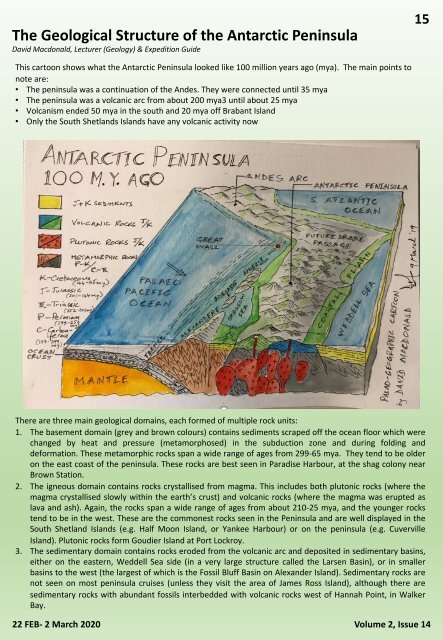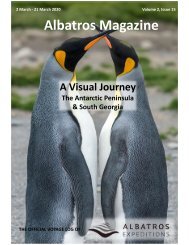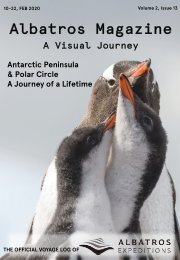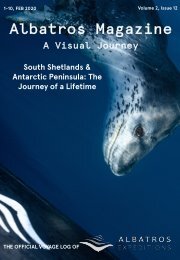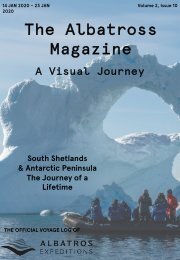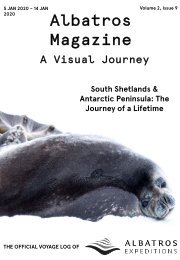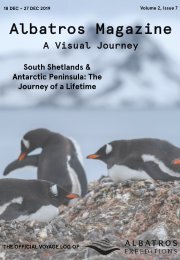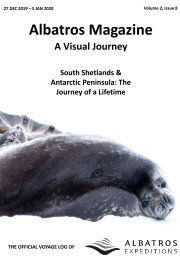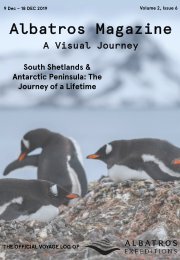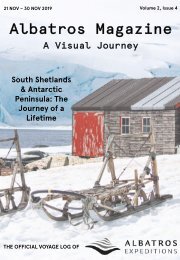South Shetlands & The Antarctic Peninsula 22 Feb 2020 - 14
Create successful ePaper yourself
Turn your PDF publications into a flip-book with our unique Google optimized e-Paper software.
<strong>The</strong> Geological Structure of the <strong>Antarctic</strong> <strong>Peninsula</strong><br />
David Macdonald, Lecturer (Geology) & Expedition Guide<br />
This cartoon shows what the <strong>Antarctic</strong> <strong>Peninsula</strong> looked like 100 million years ago (mya). <strong>The</strong> main points to<br />
note are:<br />
• <strong>The</strong> peninsula was a continuation of the Andes. <strong>The</strong>y were connected until 35 mya<br />
• <strong>The</strong> peninsula was a volcanic arc from about 200 mya3 until about 25 mya<br />
• Volcanism ended 50 mya in the south and 20 mya off Brabant Island<br />
• Only the <strong>South</strong> <strong>Shetlands</strong> Islands have any volcanic activity now<br />
15<br />
<strong>The</strong>re are three main geological domains, each formed of multiple rock units:<br />
1. <strong>The</strong> basement domain (grey and brown colours) contains sediments scraped off the ocean floor which were<br />
changed by heat and pressure (metamorphosed) in the subduction zone and during folding and<br />
deformation. <strong>The</strong>se metamorphic rocks span a wide range of ages from 299-65 mya. <strong>The</strong>y tend to be older<br />
on the east coast of the peninsula. <strong>The</strong>se rocks are best seen in Paradise Harbour, at the shag colony near<br />
Brown Station.<br />
2. <strong>The</strong> igneous domain contains rocks crystallised from magma. This includes both plutonic rocks (where the<br />
magma crystallised slowly within the earth’s crust) and volcanic rocks (where the magma was erupted as<br />
lava and ash). Again, the rocks span a wide range of ages from about 210-25 mya, and the younger rocks<br />
tend to be in the west. <strong>The</strong>se are the commonest rocks seen in the <strong>Peninsula</strong> and are well displayed in the<br />
<strong>South</strong> Shetland Islands (e.g. Half Moon Island, or Yankee Harbour) or on the peninsula (e.g. Cuverville<br />
Island). Plutonic rocks form Goudier Island at Port Lockroy.<br />
3. <strong>The</strong> sedimentary domain contains rocks eroded from the volcanic arc and deposited in sedimentary basins,<br />
either on the eastern, Weddell Sea side (in a very large structure called the Larsen Basin), or in smaller<br />
basins to the west (the largest of which is the Fossil Bluff Basin on Alexander Island). Sedimentary rocks are<br />
not seen on most peninsula cruises (unless they visit the area of James Ross Island), although there are<br />
sedimentary rocks with abundant fossils interbedded with volcanic rocks west of Hannah Point, in Walker<br />
Bay.<br />
<strong>22</strong> FEB- 2 March <strong>2020</strong><br />
Volume 2, Issue <strong>14</strong>


